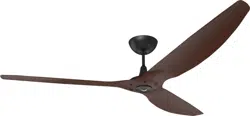#2 HOW FAST SHOULD I RUN MY CEILING FAN?
IN THE SUMMER
In the summer, the purpose of a ceiling fan is to enhance cooling by creating a breeze across your skin – this speeds evaporation of moisture on your skin, and it’s that evaporation of moisture that actually creates the cooling effect.
If you have high ceilings, when the fan is first turned on you may feel an increase in temperature as warm air is brought down from under the ceiling. This effect will soon dissipate, and then the cooling effect will begin.
Beyond this, adjust the fan for your comfort: faster if you feel warm, slower if you feel cool (or if papers are flying around the room).
Fans do not cool the air in a room. Therefore, there is no benefit in leaving a fan running when there are no people in the room; this just wastes electricity. The cooling effect of a fan takes place only when the moving air encounters a person’s skin.
Haiku’s “Smarter Cooling” setting takes care of this automatically. Big Ass Fans equipped with SmartSense technology also take the guesswork out of the process.
IN THE WINTER
In the winter, you don’t want to feel the cooling effect of a breeze across your skin. Therefore, the fan should run very slowly.
If you have high ceilings, operate the ceiling fan at its lowest possible speed to bring the warm air trapped at the ceiling down to occupant level.
If your fan can run slowly enough to not create a breeze at its lowest speed setting, it is most efficient and most effective to operate the fan in its “forward” position (blowing downward). This is true of all Big Ass Fans across our industrial, commercial and residential lines.
If you continue to feel a breeze at the lowest setting, you can still benefit by operating the fan only when there are no people in the room to feel the draft.
Haiku’s “Smarter Heating” setting takes care of this automatically, as does SmartSense technology on Big Ass industrial fans.


